6/3/2025 Update – The DreamCloud Premier Rest has been discontinued and replaced by the new DreamCloud Luxe Hybrid. You can see our full review here.
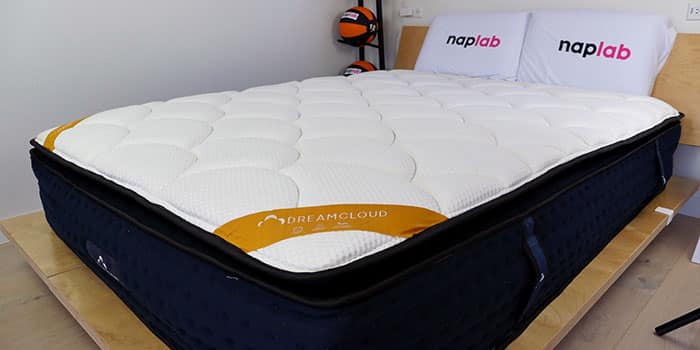
Best For
- Motion transfer was extremely low, 2.62 m/s². Average motion transfer is 5.68 m/s².
- Budget-friendly, as far as hybrid mattresses go.
- Moderate level of bounce, despite the dense motion absorbing foams.
Considerations
- Cooling leaves something to be desired. All 3 Nectar mattresses, including the least expensive, outperformed the DreamCloud Premier Rest.
- Very slow response time. 2nd slowest we’ve tested to date.
- Edge support isn’t great for both sitting or lying.
Our Verdict
The DreamCloud Premier Rest is a 16″ high-profile hybrid option with a pillow top cover, poly foam, and pocketed coil support system. It has a medium firmness, around 6 out of 10 on the firmness scale, where 10 is the most firm.
It has moderate sinkage and low bounce, offering a strange feel due to the top comfort layers.
The mattress has an overall score of 7.88, placing it in the bottom 15% comparing to all the mattresses we’ve tested to date. Looking at hybrid mattresses exclusively, the Dreamcloud Premier Rest scores in the bottom 9%.
For a queen mattress, it is $1,399, 5.9% more expensive than the average hybrid mattress.
Overall, I’m just not a huge fan of this mattress. It struggles in several important categories, including cooling, response time, and edge support. While hybrid design usually means these categories perform better, we don’t see it here. In my view, Nectar (DreamCloud’s sister brand) is the better choice for almost every consumer. See our Nectar Premier Copper review for a score comparison.
Type: Hybrid
Firmness: Medium Firm (6)
Best For: All Sleeping Positions, All Body Weights
In This Review
Performance Tests | Firmness | Support & Sleeping Positions | Design | Materials | Comparisons | FAQs
Performance Tests
At NapLab, we put each mattress to the test.
We test 10 different factors that impact the performance, comfort, and value of the mattress. We then take the results of that test and compare to every mattress we’ve tested to date.
Check out the full performance table below to see how this mattress ranks:
| Factor | DreamCloud Premier Rest | Average |
|---|---|---|
| Overall Score | 7.88 | 8.55 |
| Price (Queen) | $1,399 | $1,316 (Hybrid only) |
| Cooling – Score | 7.0 | 8.7 |
| Sinkage – Depth | 2.18″ | 2.15″ |
| Sinkage – Feel | Moderate | Moderate |
| Motion Transfer – Score | 10 | 8.2 |
| Motion Transfer – Acceleration | 2.62 m/s² | 8.79 m/s² |
| Response Time – Score | 5.0 | 8.9 |
| Response Time – Mostly Recovered | 3.7 sec. | 0.4 sec. |
| Response Time – Fully Recovered | 4.5 sec. | 0.9 sec. |
| Bounce – Height | 7.88″ | 9.52″ |
| Bounce – Feel | Low | Moderate |
| Edge Support – Score | 6.5 | 8.6 |
| Edge Support – Sitting | 5.50″ | 4.05″ |
| Edge Support – Lying | Mediocre | Good |
| Sex – Score | 7.4 | 8.4 |
| Pressure Relief – Score | 8.0 | 8.7 |
| Comfort Layer Thickness | 6.5″ | 4.1″ |
| Mattress Thickness | 16″ | 12.0″ |
| Off-Gassing – Score | 9.7 | 8.2 |
| Off-Gassing – Smell | Minimal | Strong |
| Off-Gassing – Days | 1 day | 6 days |
| Company – Score | 10 | 8.8 |
| Trial | 365 nights | 178 nights |
| Warranty | Lifetime | 25% have lifetime warranties, average of other 75% of mattresses is 13 years |
How is the DreamCloud Premier Rest Different?
The Premier Rest hybrid by DreamCloud has lower performance than the average mattress and also a slightly higher price tag—6% more than the average hybrid.
Advantages
The mattress has very low levels of motion transfer, 70% better than average. This mattress is also 16″ thick, over 4″ thicker than average which also allows for a thicker comfort layer (6.5″ compared to the 4.1″ average).
Neutral Factors
Considering neutral factors, the Premier Rest has sinkage that is right at the average level as well as 17% less bounce than average. Sinkage and bounce are more preferential factors than anything else, but certainly worth considering.
Disadvantages
The Premier Rest has poorer cooling than the average mattress by a pretty considerable margin and a significantly slower material response time, over 9X slower than average.
Edge support was also a struggle with 36% more sinkage when seated at the edge of the mattress.
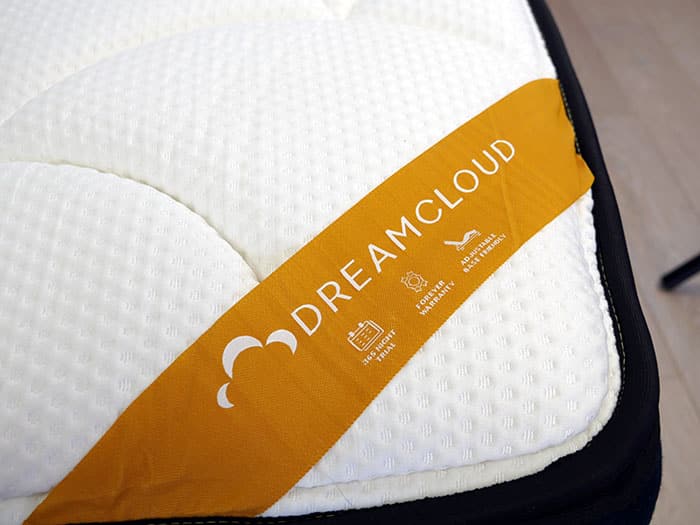
Cooling Test
The cooling experience on the DreamCloud Premier Rest mattress was fair, but not great.
In our objective data, we measured a maximum surface level temperature of 91.7°. This is 2.1° higher than the average maximum temperature across all mattresses we’ve tested to date (which is 90.9°).
Baseline Temp.
79.4°F
Max. Temp.
91.7°F
Ending Temp.
84.5°F
Max. Temp.

Ending Temp.

- Baseline Temperature – the temperature of the mattress before anyone lies on it
- Maximum Temperature (0 minute) – the temperature of the mattress after lying on it for 15 minutes
- Ending Temperature (5 minute) – the temperature of the mattress after being lied upon and having no one on it for 5 minutes
The heat dissipation curve was also good, just not great. By the 1-minute mark after getting off the mattress the Premier Rest hit a surface-level temperature of 87.4°F. This is a decline of 4.3°.
While the total decline between 1 and 5 minutes is good (ending at 84.5°F), the absolute temperature isn’t great.
Between the three DreamCloud mattresses we tested, it was the worst when it came to heat dissipation and was also just slightly less hot at its max temperature (edged out by 0.3°by the DreamCloud Premier). See our original DreamCloud mattress review here.
Heat Dissipation Over Time
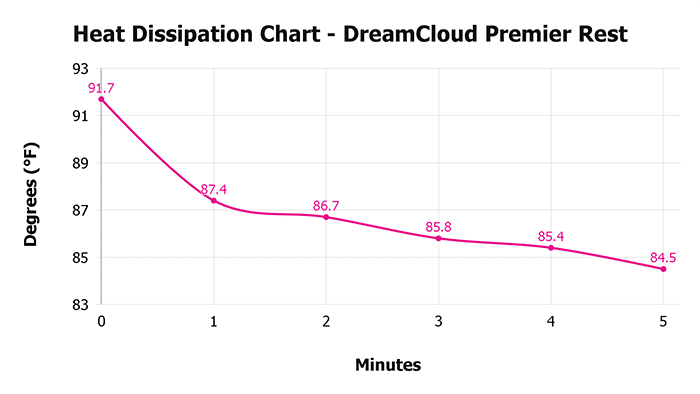
Subjectively speaking, my experience during the cooling test left something to be desired. I did feel a noteworthy level of heat retention around my body.
The dense top layers of memory foam just don’t seem to breathe as well as other mattresses we’ve tested.
Cooling: DreamCloud vs. Nectar
Given that DreamCloud is part of the Nectar family of mattresses, I kept comparing it to the Nectar line.
While I do appreciate the price point of the DreamCloud mattresses, it feels clear to me that there is something missing in the materials.
The Nectar, Nectar Premier, & Nectar Premier Copper outperformed (or tied) the Dreamcloud Premier Rest in almost every single category, but especially in cooling.
Sinkage Test
In our sinkage tests, we measured 2.18” of sinkage. This is pretty typical for a medium-firm mattress.
Sinkage Depth
2.18″
Sinkage Feel
Moderate
The level of sinkage is documented in the image below.
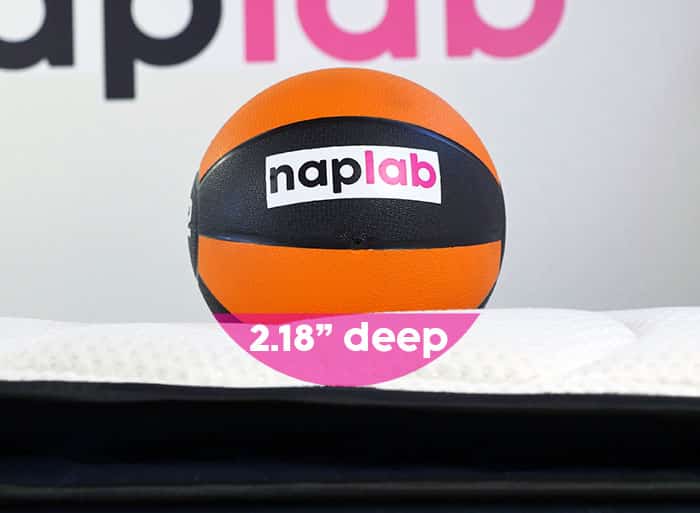
The average sinkage depth across all mattresses we’ve tested to date is 2.15”, so the DreamCloud Premier Rest is close to average.
Two’ish inches of sinkage is a reasonable level to create good contour and hug, without being so deep as to create new issues.
Motion Transfer Test
Motion transfer for the DreamCloud Premier Rest was extremely low. Our accelerometer measured an acceleration range of 2.62 m/s².
Accel. Range
2.62 m/s²
Motion Duration
0.61 seconds
The level of motion transfer is documented in the video below.
This is among the lowest motion transfer levels we’ve tested to date, and also significantly better than the DreamCloud Premier & original DreamCloud mattress.
The average motion transfer across all mattresses we’ve tested to date is 6.17 m/s². Looking at the motion transfer chart we can see that most of the energy is dissipated by 0.2 seconds.
Motion Transfer Over Time
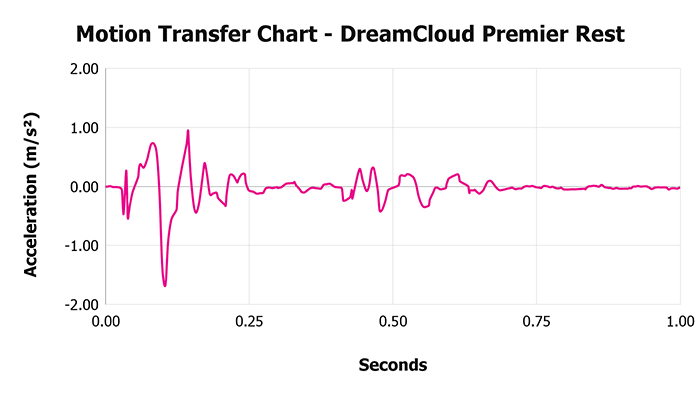
A moderate level of energy persists up until 0.61 seconds, before returning to near-zero levels. This is a fast dissipation timeframe. Very few mattresses will offer superior motion transfer compared to the DreamCloud Premier Rest.
Response Test
Response time on the DreamCloud Premier Rest mattress is slow, very slow. It is the 3rd slowest responding mattress we’ve tested to date, only being edged out by the original DreamCloud and one other mattress.
Mostly Recovered
3.7 sec.
Complete Recovery
4.5 sec.
The level of responsiveness is documented in the video below.
It takes 3.7 seconds for the materials to mostly recover and full recovery takes 4.5 seconds.
On average, it takes a mattress 0.4 seconds to mostly recover and 0.8 seconds to fully recover (based on our full library of testing data to date).
As a result, if you are the type of sleeper who feels untrapped or “stuck” by the feel of foam, you may want to consider a faster-responding alternative.
Nectar’s Premier (0.4 seconds) and Nectar’s Premier Copper (0.3 seconds) were both significantly faster when it came to the response. The Purple mattress, Nest Bedding’s Owl, Leesa Legend, and Ghostbed Luxe are all other super fast-responding mattresses. Each of these has a mostly recovered response time of 0.2 seconds.
Bounce Test
Bounce height was moderate to low for the DreamCloud Premier Rest. We measured a total bounce height of 7.88”.
Max. Depth
5.01″
Max. Rebound
2.87″
Total Bounce
7.88″
On average, we see a total bounce height of 9.52”. The Dreamcloud Premier Rest is a good bit below average but still has a reasonable level of bounce.
Max. Sinkage Depth

Max. Bounce Height

The level of bounce is also documented in the video below.
While bounce is a preferential factor, it does make moving around on the mattress easier, getting in and out of bed, and, of course, improves sex.
Edge Support Test
Edge support, for both lying and sitting, isn’t good on the DreamCloud Premier Rest. In our objective tests, we measured a maximum compression of 5.5”. This is notably more than the average, which is 4.05”.
Max. Sinkage
5.5″
Lying Support
Mediocre
While sitting directly on the edge of the mattress you can see the significant compression applied to the mattress and the lack of support.
The level of edge support while seated is documented in the images below.
Sitting, 140 lbs.
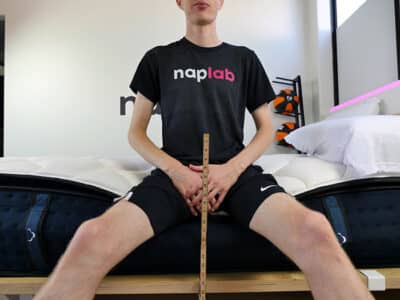
Sitting, 200 lbs.

While sitting support on the edge isn’t good, lying edge support was worse.
The level of edge support while lying is documented in the images below.
Lying on Edge, 140 lbs.

Lying on Edge, 200 lbs.

I did not feel well supported while lying directly on the edge of the mattress. In addition, I felt that the mattress was trying to roll me off of the bed.
When I cut up the cover to examine the internal foam layers I noticed that the top layer is both not well glued and also has a significant tapered slope towards the edge.
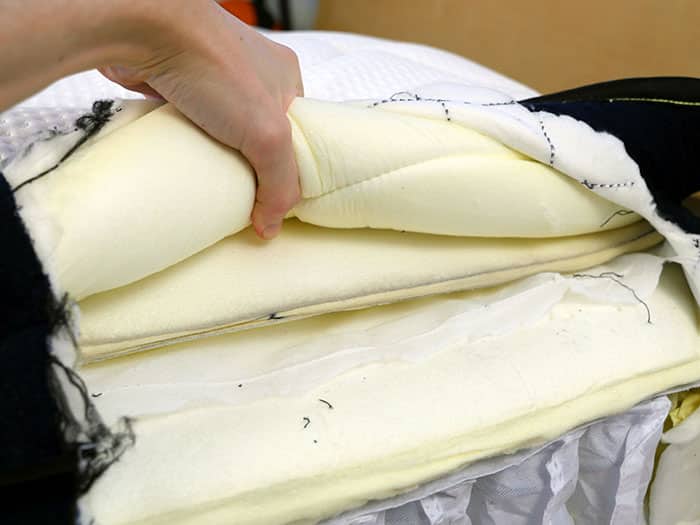
These factors are combined to exacerbate edge support issues, which results in an edge that isn’t capable of supporting sleepers.
Honestly, I was very surprised by the edge support on the Premier Rest. Edge support performance on the original DreamCloud and DreamCloud Rest mattresses were both significantly better by comparison.
It was strange and unexpected to see so many edge support issues with the highest-end DreamCloud mattress.
Sex Test
The best mattresses for sex have high bounce, good edge support, quiet materials, and good pressure relief and cooling.
These 5 factors make up the NapLab sex performance score.
| Sex Factor | Factor Weight | Score | Rating |
|---|---|---|---|
| Bounce | 65% | 7.4 | Moderate |
| Edge Support | 20% | 6.9 | Mediocre |
| Noise | 5% | 10 | Minimal |
| Pressure Relief | 5% | 8.0 | Good |
| Cooling | 5% | 7.0 | Fair |
Sex performance is fair for the DreamCloud Premier Rest. Although the score isn’t bad, the Premier Rest has moderate to low bounce. Bounce is really important for good sex and we’ve definitely seen higher levels from other mattresses.
In addition, pressure relief is good, but not great. With two sleepers close together, there’s a greater chance that there could be some pressure point issues arising.
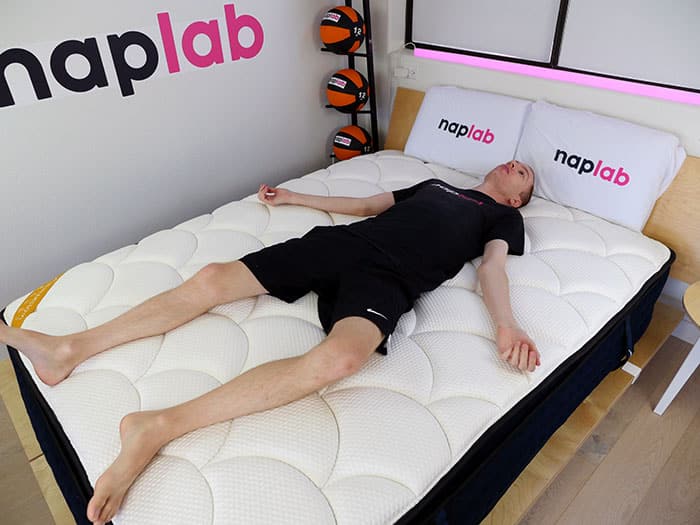
Edge support was also notably lacking. While sitting, there was 5.5″ of give, which is not nothing. Even with the thicker profile of the Premier Rest, this is still over 30% of the thickness of the total mattress.
Edge support while lying is worse than sitting, so if you’re looking for some spooning after sex, make sure you’re in the middle of the mattress.
Lastly, cooling on the Premier Rest was okay, but not great. It struggled with heat retention and again, with two sleepers on the mattress getting it on, a little extra heat can go a long way, and really starts to feel uncomfortable.
Pressure Relief Test
Pressure relief on the DreamCloud Rest mattress was strange. The top layer of foam has a peculiar feeling, and not in a good way. It doesn’t feel very well glued.
Comfort Layer
6.5″
Support Layer
9.5
As a result, the layer feels like it’s less a part of a greater whole mattress and more that it’s an independent layer (almost like a detached foam topper).
The feel it creates is somewhat strange and certainly a unique feel among mattresses.

In my view, this creates a less-than-ideal pressure relief dynamic. Instead of the series of layers working together to gradually ease your body into the mattress and relieve pressure, you end up with what feels more like a solid core mattress topper.
I wouldn’t go as far as to say the pressure relief is bad, but it’s not as good as others we’ve tested by a healthy margin.
Off-Gassing Test
Off-gassing was surprisingly good. The Dreamcloud uses deodorizer packs and they really do seem to make a big difference.
Initial Smell Strength
Minimal
Off-Gassing Period
1 day
There was a minor smell upon the initial unboxing and that smell only lingered for 1 day. This is notably better than the average.
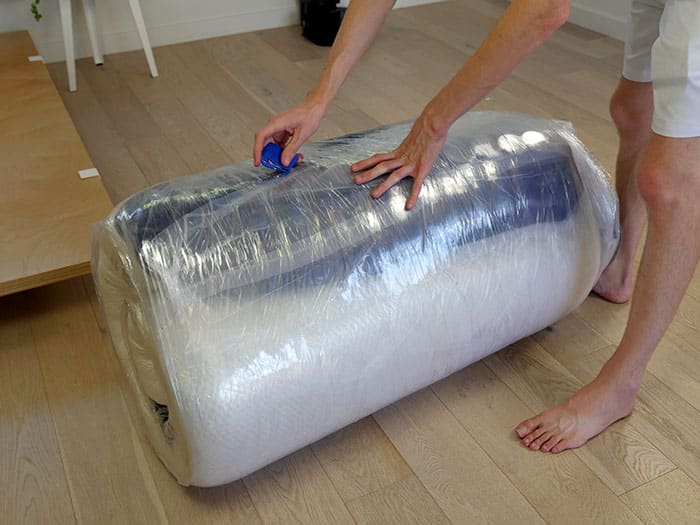
The mattresses we’ve tested have a strong smell for 6.5 days on average.
Company
The company score takes a look at factors that may influence your experience with the mattress.
Factors include length of the trial period, warranty, shipping / return costs, and country of origin.
| Company Factor | Factor Weight | Score | Data |
|---|---|---|---|
| Returns | 40% | 10 | $0 |
| Trial Period | 30% | 10 | 365 nights |
| Warranty | 20% | 10 | Lifetime |
| Shipping | 10% | 10 | $0 |
| Country of Origin | 0% | USA |
DreamCloud’s company policies are pretty good and consumer-friendly, in my opinion. If you’re familiar with Nectar’s lineup, these terms and conditions may look familiar. They are very similar.
DreamCloud offers a 365-night trial and a limited lifetime warranty. The warranty covers defects or flaws in the materials or construction of the item as long as you own it.
Comparing all mattresses tested to date, this trial is 105% longer and the warranty is part of the 25% of mattresses we’ve tested with lifetime warranties (the average of the other 75% is 177 nights).
Unrepairable issues within the first 10 years are offered a brand new mattress. Issues after the first 10 years are still offered the same mattress, but the customer pays a $50 shipping fee.
Shipping is free. Returns are free. And the mattress is made in the US. All of these factors earn DreamCloud a perfect score when it comes to company terms.
How firm is the Premier Rest?
The firmness of the Premier Rest is around a true medium firm, 6 out of 10 on the firmness scale.

This firmness level makes it a solid choice for a wider range of sleepers. The softer pillowtop is nice for side sleepers especially.
Support & Sleeping Positions
In general, support on the Premier Rest mattress is good.
Here is a full breakdown of sleeper profiles that we think align the best with this mattress:
| Sleeper Weight | Stomach Sleepers | Side Sleepers | Back Sleepers |
|---|---|---|---|
| Under 150 lbs. | Yes | Yes | Yes |
| 150-250 lbs. | Yes | Yes | Yes |
| 250-300 lbs. | Yes | Yes | Yes |
The Premier Rest hybrid has a 16″ thick profile, 8.5” of pocketed coils, and sufficient comfort materials.
My only concern is that some sleepers may find the pressure-relieving dynamic so strange that it creates the potential for support problems.
Ultimately, this is a comfort issue that could impact support, but not a direct support issue.
Design
The DreamCloud Premier Rest is a plush hybrid with a high 16″ profile, and dynamic use of pocketed coils, support foam, and comfort foam.
Type
Hybrid
Thickness
16″
Firmness
6

Materials
The Premier Rest is the thickest mattress that DreamCloud currently offers. It is 16″ and has a plush pillowtop cover followed by layers of foam and coils combined.
The exact breakdown is as follows, from top to bottom:
- 2.0″ pillowtop
- 2.5″ poly foam
- 2.0″ poly foam
- 8.5″ pocketed coils
- 1.0″ support foam
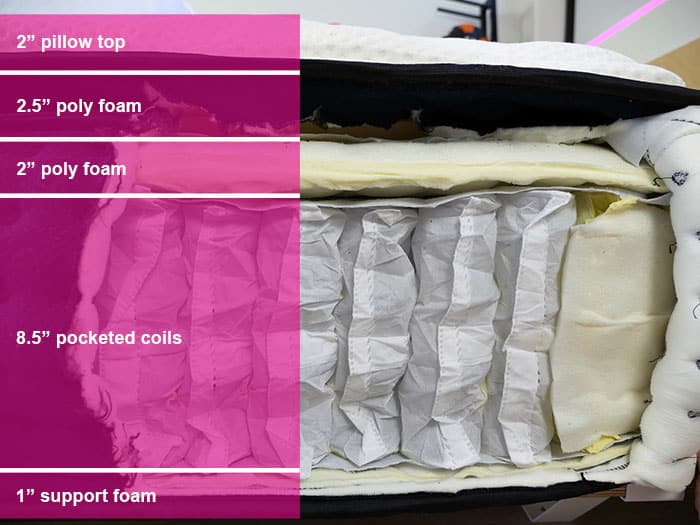
The Cover
The cover of the DreamCloud Premier Rest is the same cashmere blend that’s on some of their other mattresses. It is ultra-soft, stretchy, and breathable.
Despite using the same cover material, the Premier Rest is quite a bit different in that there is a 2.0″ thick pillowtop layer.

This creates more hug and contour, which can be a real plus, especially for side sleepers. It still has a light-colored top with scalloped stitching and dark sides with micro-tufted accents.

There are also four handles, two on each side, for moving around the mattress easier.
The Comfort Layer
Below the 2.0″ thick pillow top, is 4.5″ of comfort foam. This layer is broken up into two layers of poly foam, each with varying densities.

As I mentioned above, I didn’t love the craftsmanship of the foams here. The glue feels a little weak (or missing) and the layers don’t seem to be as strongly held together. As a result, the foams didn’t perform as well as I expected them to, especially considering this is DreamCloud’s top-of-the-line mattress.
The Support Layer
The primary support of this mattress is the 8.5″ layer of pocketed coils. This layer includes hundreds of coils, all individually pocketed.

This keeps noise down and also allows the coils to work independently of each other, responding to individual pressure applied to each coil, instead of as a whole.
Below the coils is a simple 1.0″ thick ultra-dense support foam. More than comfort, this foam’s main job is to support the coils and foam above.
Sleepers are not intended to ever interact with this foam directly.
Product Evolution
DreamCloud first launched in 2018, following the launch of Nectar in 2017 by the same parent company.
DreamCloud was developed as a luxury mattress line with a higher profile and high-end materials.
For DreamCloud, the Original Luxury Hybrid was the first mattress available. From there, came the development of two other models, the DreamCloud Premier, DreamCloud Premier Rest, and an assortment of bases and foundations.

Premier vs. Premier Rest
This review covers the DreamCloud Premier Rest, but how is it different from the DreamCloud Premier? With nearly the same name, it can be difficult to tell these models apart.
Check out the similarities and differences below:
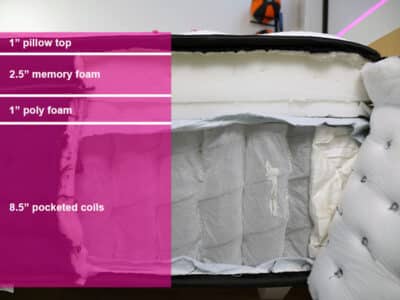
Premier
| Type: Hybrid |
| Thickness: 14″ |
| Cover: Pillow Top |
| Firmness: 7 out of 10 |
| Price: $1,399 (queen) |
| Overall Score: 9.08 |
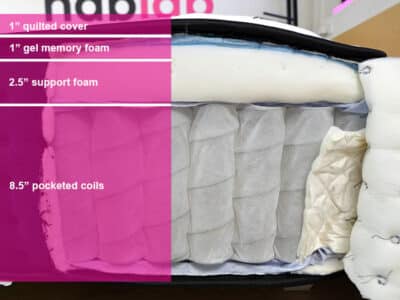
Premier Rest
| Type: Hybrid |
| Thickness: 16″ |
| Cover: Pillow Top |
| Firmness: 6 out of 10 |
| Price: $1,599 (queen) |
| Overall Score: 7.88 |
As you can see, the Premier Rest is 2.0″ thicker than the standard Premier. It’s also just a touch softer. Although the Premier Rest costs a bit more, I’m not entirely sure that the value is really there, as the standard Premier actually performed better in our tests.
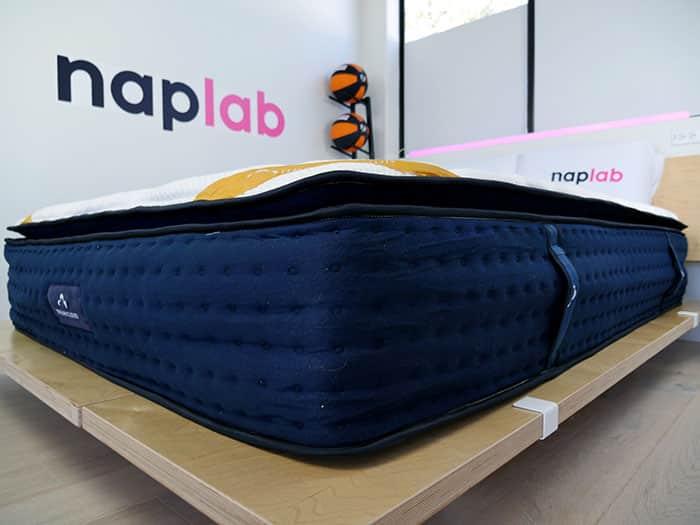
Unless you are specifically looking for a pillow top or ultra-high profile mattress, I would likely recommend the DreamCloud Premier over the Premier Rest.
Other Mattresses to Consider
Aside from the Premier, you may also want to consider one of the following mattresses below. They offer some distinct advantages over the Premier Rest.
For Faster Response
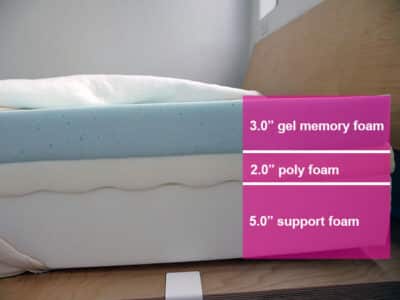
eLuxury Supply
100% Foam Mattress
For the memory foam feel, but with a faster response time, consider the eLuxury Supply mattress. This mattress was mostly recovered within 1.2 seconds and completely recovered within 2.0 seconds.
For Cooling

Nectar Premier
Luxury Memory Foam
Although it’s a memory foam mattress, the Nectar Premier was still a better performer than the Premier Rest. This mattress is 13″ thick with a top layer of gel memory foam that really is great for heat dissipation and cooling.
For Edge Support

Brooklyn Bedding Signature
Latex Foam + Coils
The Brooklyn Bedding Signature hybrid offers a blend of latex foam, poly foam, and pocketed coils. The edge support is fantastic, only 2.75″ max sinkage, when sitting directly on the edge.
Frequently Asked Questions
Still have questions? Check out some of the top FAQs on the DreamCloud Premier Rest mattress below and get the answers you’re looking for.
The cost of the DreamCloud Premier Rest mattress varies depending on what size you’re looking for. Here are the current prices, with any sales or promotions reflected below:
Twin: $1,099
Twin XL: $1,299
Full: $1,499
Queen: $1,599
King: $1,899
Cal. King: $1,899
*Note: Sales prices are subject to change without notice or warning.
The purchase of any DreamCloud mattress comes with a 365-night trial period.
No. The best way to try out this mattress is to take advantage of the 365-night trial period. This lets you try the mattress in your own home.
Cleaning the DreamCloud mattress is similar to how you would clean any other foam-based mattress. You can spot clean with cold water and mild detergent or vacuum the mattress. To avoid stains and spills altogether, consider adding a waterproof mattress pad or a 6-sided mattress encasement.
The Premier Rest has a 16″ profile, which includes 2″ of extra comfort material, while the Premier has a 14″ profile and less comfort material. The Premier also has a firmer feel, around a 7 out of 10, while the Premier Rest feels more like a 6 out of 10 on the firmness scale. Lastly, the Premier Rest is a bit more expensive than the Premier.
Yes and no. Both Nectar and DreamCloud are owned by the same parent company, Resident, but they operate a separate digital storefront, branding, and marketing. There is also no overlap with orders. For example, you cannot return a Nectar mattress to DreamCloud, or vice-versa.



